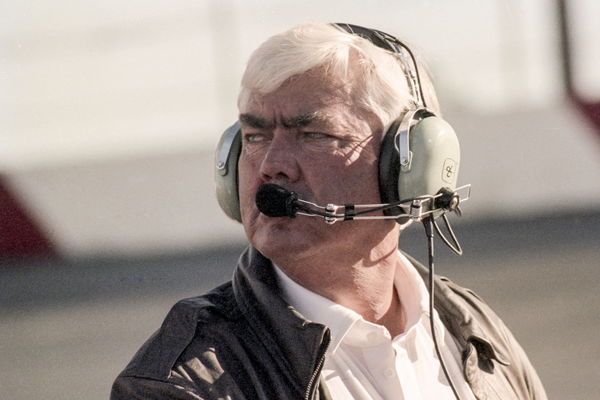
via Getty
HAMPTON, GA – NOVEMBER 18: Junior Johnson watches from the pits during the Atlanta Journal 500, NASCAR Winston Cup race, Atlanta Motor Speedway on November 18, 1990 in Hampton, Georgia.. (Photo by Brian Cleary/Getty Images)

via Getty
HAMPTON, GA – NOVEMBER 18: Junior Johnson watches from the pits during the Atlanta Journal 500, NASCAR Winston Cup race, Atlanta Motor Speedway on November 18, 1990 in Hampton, Georgia.. (Photo by Brian Cleary/Getty Images)
The Last American Hero is Junior Johnson: Yes!” – The famous essay by Tom Wolfe from 1965 has proven to hold so much weight that it’s not only been adapted into a feature-length Hollywood classic but also showcased itself when Junior Johnson bent NASCAR’s rules once again to chase victory at America’s greatest racetrack only four years later.
In 1969, Leeroy Yarbrough would drive the last car of its kind to win a race, owing to how controversial its exhaust setup was. Junior Johnson’s team had figured out a way to not only gain additional horsepower by running tailpipes instead of side exits but also outright change the dynamics of SuperSpeedway racing. But what was so special about Johnson’s creation and why did NASCAR have to put a premature end to Yarbrough’s newfound dominance?
ADVERTISEMENT
Article continues below this ad
How Junior Johnson’s team outsmarted the field in 1969
It all began in 1969 when Ford and Mercury introduced the new 429 cubic inch engine, which was eventually banned from the Daytona 500 since it wasn’t yet past the quota for production cars sold. However, that wasn’t the only hurdle in their way, as the teams also decided to run rear exits. While many believed this would be the cause of concern owing to the possibility of back pressure from the engine, the bigger concern was raised by the drivers themselves.
Poll of the day
Poll 1 of 5
AD
After practice had concluded at Atlanta Motor Speedway that year, Cale Yarbrough and Richard Petty were the first to ring the alarm bells. Petty wished to return to the side exits because the new tailpipes would kill engine noise that was essential for feedback during the race. And turns out, Yarbrough was right as well. At the end of the weekend at Atlanta, Yarbrough would take victory at the checkered flag running the side exhaust instead.
This would all change when David Pearson made an intriguing revelation about running tailpipes. He shared in 1969, “On horsepower range, it shows that running them out the back helps, but you only get about two more horsepower.” While it may seem like an insignificant number to many, the benefit of running rear exits would soon reveal itself when Junior Johnson decided to utilise them for his driver, LeeRoy Yarbrough, for the Firecracker 400 at Daytona. After all, it was Yarbrough who had won the Daytona 500 earlier in the year after he slingshotted past Glotzbach on the last lap.
On Yarbrough’s return to Daytona, crew chief Herb Nab went against what others had advised and ran rear exhausts after qualifying. While he had started in 9th, his car would leapfrog to the front without wasting any time and it was clear to all that the rear exits were doing wonders. However, there was a big factor involved in Yarbrough’s trip to the FireCracker 400 victory lane, which was the ultimate reason Herb Nab’s idea was banned.
Running rear exits meant the hot exhaust gases would directly blow onto the drivers running behind, and this would eliminate the ability to draft by creating dirty air in the wake of the car. While Yarbrough and Nab believed they had outsmarted the pack and changed drafting dynamics to their advantage, it caused the community to point out how Superspeedway racing would change forever.
ADVERTISEMENT
Article continues below this ad
Top Stories
NASCAR saves the day for fans of Superspeedway Racing despite Junior Johnson’s disapproval
On a visit back to Atlanta a month later, the community’s doubt would turn into fear after most cars turned up running rear exits, which meant the bumper-to-bumper action would now become a rare sight. Fortunately for fans and unfortunately for Johnson’s team, this is when NASCAR officials decided to step in.
Unfortunately for those who arrive at Atlanta Motorspeedway hoping to mimic LeeRoya Yarbrough’s heroics at the Firecracker 400, Bill Gazaway would bring down the ban hammer on the tailpipes. The Technical Director shared, “I don’t think it’s safe. The drivers get most of their air through the front of their cars, and I don’t believe it’s good to have all that hot air and exhaust gases blowing back at them.”Not only would rear-end exits create aerodynamic issues for drivers running closely behind the frontrunners, but if the engine were to have issues it would cause hot liquid and even debris to fly directly toward the car behind.
ADVERTISEMENT
Article continues below this ad
WATCH THIS STORY: Kenny Wallace: A NASCAR legend’s Hall of Fame induction
Even though the innovation by Junior Johnson’s team was well within the rules when it all went down, NASCAR’s ban prompted LeeRoy Yarbrough to burst out in laughter – “Junior Johnson got another rule change.”
ADVERTISEMENT
ADVERTISEMENT
ADVERTISEMENT
ADVERTISEMENT

